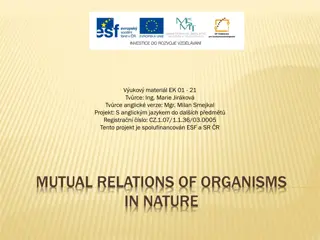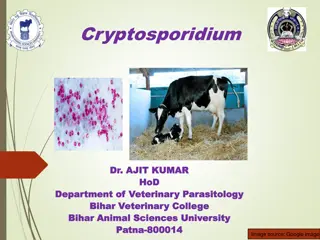Exploring the Thermophilic Organisms: Thermoplasma Genus
The Thermoplasma genus belongs to Archaea and thrives in acidic, high-temperature environments. These prokaryotic organisms lack a defined nucleus and utilize sulfur and organic carbon for respiration. They possess a unique membrane composition, allowing them to survive in extreme conditions. Species like T. acidophilum and T. volcanium have been discovered in coal refuse and volcanic areas, respectively, showcasing their adaptability to harsh environments.
Download Presentation

Please find below an Image/Link to download the presentation.
The content on the website is provided AS IS for your information and personal use only. It may not be sold, licensed, or shared on other websites without obtaining consent from the author.If you encounter any issues during the download, it is possible that the publisher has removed the file from their server.
You are allowed to download the files provided on this website for personal or commercial use, subject to the condition that they are used lawfully. All files are the property of their respective owners.
The content on the website is provided AS IS for your information and personal use only. It may not be sold, licensed, or shared on other websites without obtaining consent from the author.
E N D
Presentation Transcript
VMC602 Dated-30/12/2020 Dr. Sudha Kumari Assistant Professor Department of Veterinary Microbiology Bihar Animal Sciences University, Patna
Thermoplasma Thermoplasma Thermoplasma, (genus Thermoplasma), any of a group of prokaryotic organisms (organisms whose cells lack a defined nucleus) in the domain Archaea that are noted for their ability to thrive in hot, acidic environments. The genus name is derived from the Greek therm and plasma, meaning warmth (or heat ) and formative substance, respectively, which describe the thermophilic (heat-loving) nature of these organisms. Thermoplasma are members of class Thermoplasmata.
Thermoplasma is a genus of archaea. It belongs to the Thermoplasmata, which thrive in acidic and high-temperature environments. Thermoplasma are facultative anaerobes and respire using sulfur and organic carbon. They do not contain a cell wall but instead contain a unique membrane composed mainly of a tetraether lipoglycan containing atypical archaeal tetraether lipid attached to a glucose- and mannose-containing oligosaccharide. This lipoglycan is presumably responsible for the acid and thermal stability of the Thermoplasma membrane..
They are capable of both aerobic and anaerobic metabolism. Their survival in anaerobic habitats is dependent on sulfur respiration, a form of chemolithotrophic metabolism in which carbon and energy are obtained from the reaction of sulfur with organic compounds. The organisms also occur in heat-generating coal refuse sites, which produce sulfuric acid via oxidation of pyrite wastes from coal-mining operations. Thermoplasma growth typically requires a pH range of 0.8 to 4.0 and a temperature range of approximately 45 to 60 C (113 to 140 F); optimal growth has been reported at pH 1 2 and 59 C.
Species of Thermoplasma 1. T. acidophilum, discovered in coal refuse and first reported in 1970, and 2. T. volcanium, initially discovered in solfataric fields on Vulcano Island, Italy, and reported in 1988. Similar to other archaea, these organisms lack a cell wall and instead possess a specialized cell membrane made up of ether- linked molecules of glycerol and fatty acids. In Thermoplasma this structure is uniquely adapted to the stress of living in acidic, hot, high-salt habitats.
T. Acidophilum T. acidophilum was originally isolated from a self-heating coal refuse pile, at pH 2 and 59 C. Its genome has been sequenced. It is highly flagellated and grows optimally at 56 C (133 F) and pH 1.8. The size of a cell is about 1 m. T. acidophilum lacks a cell wall and the cell membrane is exposed directly outside. T. acidophilum shows various cell shapes depending upon growth conditions and stages.
Thermoplasma volcanium It is a moderate thermoacidophilic archaea isolated from acidic and solfatara fields. It contains no cell wall and is motile. It is a facultative anaerobic chemoorgano heterotroph. No previous phylogenetic classifications have been made for this organism. Thermoplasma volcanium reproduces asexually via binary fission and is nonpathogenic. Hydrothermal vents Ahydrothermal vent is a fissure on the seafloor from which geothermally heated water discharges.
Hydrothermal vents are commonly found near volcanically active places, areas where tectonic plates are moving apart at spreading centers, ocean basins, and hotspots. Hydrothermal deposits are rocks and mineral ore deposits formed by the action of hydrothermal vents. Thermoplasma volcanium was isolated from acidic hydrothermal vents off the shores of the beaches of Vulcano, Italy by Segerer et al. in 1988.
Morphology of Thermoplasma volcanium Isolates take on different shapes depending on their placement within the growth curve. During early logarithmic growth, the isolates take on forms of all shapes including, but not limited to, coccoid-, disc-, and club-shaped of around 0.2-0.5 micrometers. During stationary and late logarithmic growth phases, the isolates primarily take on a spherical (coccoid) shape and can produce buds around 0.3 micrometers in width that are thought to contain DNA. A single flagella is present on the organism, emerging from one polar end of the cell. The Thermoplasma volcanium isolates have no cell envelope or cell wall.























